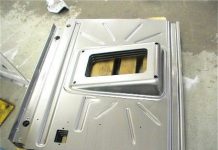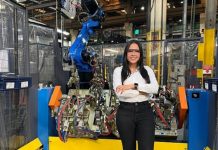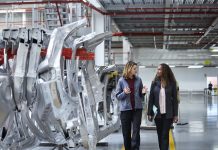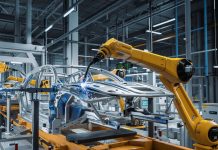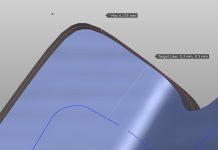Is Industry 4.0 Already Here?
Talking about communicating, transferring information or data in an era where these functionalities have been made simpler than ever may sound silly; well, I can assure you that data, or more generically “information”, travelling from the engineering to the tryout department within a company operating in the sheet metal forming industry, is everything but trivial or taken for granted.
Today’s car bodies are made of 150 to 200 individual sheet metal parts, assembled together to work as “one” single body. Each single part is created from an “idea” or a draft on a paper that turns (after different studies) into a CAD drawing or model; the metal forming process will transform that drawing into a real part.

The forming process is quite complex and we, at AutoForm, have always put our efforts into trying to simplify and improve communication and data flow by providing solutions along the entire process chain: from the early feasibility studies to the process engineering and process design, up to tryout and production, always keeping in mind which factors are driving the process as it evolves and matures.
The figure below summarizes AutoForm’s view regarding the tasks that need to be performed in the creation process of a complex sheet metal part. Each task aims at achieving certain goals to be reached at its milestone to make the “idea” come true, meaning the production of a real sheet metal part which at the beginning was a “simple” drawing or 3D CAD model.
Figure 1 – Sheet Metal Forming Process Chain
In creating solutions to support designers along the entire process we need to consider what we call “Decision Drivers”, the factors that steer designers towards a certain direction rather than another one. When the first studies are made designers mostly think about the “function” each part has to perform and how much it is going to “cost” when produced which depends also on the targeted quality. Once all those studies have been performed and the decisions have been made accordingly, what really becomes fundamental is lead time; time needed to make the tools that will shape a flat sheet into a part, time that must fit the plan and therefore the deadline represented by the “time-to-market”.
Transferring data generated in Process Engineering and Process Design (identified as individual tasks in AutoForm’s Comprehensive Digital Process Plan, see fig. above) to Tryout in a way that can actually profitably be used is quite significant and important: data leave the virtual world of engineering and CAD to enter the real world of die tryout where the initial “idea” becomes “reality”, where a flat metal blank turns into a complex real-life sheet metal part!
During process engineering and process design the involved departments work with high synergy in a virtual environment involving simulation software (CAE) and CAD products with the aim of trying to predict reality. During this work period different parameter values and tool shapes are evaluated until a “working” scenario (parameter set) is found. Once the process plan and tool geometries are validated using process simulation the tool construction process can begin.
Here comes the big step: data leaving the digital world to step into reality.
To make this passage as smooth and as effective as possible a large amount of data should be transferred downstream to the tryout department. After all, process engineers – using their simulation tools – have already become intimately familiar with the part and the process details. They already have tried out – although in digital form – many different process scenarios. Input data, meaning process parameters, and target results, meaning shape, dimensions and quality of the sheet after each operation, are set and transferred, as already mentioned, to tryout by creating reports in various formats.
Ideally, if everything goes well, the intended results are achieved during the first stamping tryouts, the tool tryout period can be short and cheap and the tools are ready for production or home-line tryout.
Unfortunately, this is not the rule.
Draw die tryout is an iterative “tuning” process that often consumes a lot of time and resources. Parts may split or crack before reaching the bottom of the stroke, or wrinkles appear in some area. In other words, the sheet can be more or less far from the production process intent (different springback behavior, out of dimensional tolerances, unacceptable quality). When this happens (quite often) tryout experts try to determine which parameter(s) might be responsible for the forming issues and take the most appropriate countermeasure(s).
Different possibilities and different assumptions are evaluated based on the experience of the person leading the process. Binder pressure, blank position, and the drawbead restraining forces are some of the parameters they can adjust to make the die work. This trial-and-error process goes on until the desired target is reached. It might take a day, or a week or months during which, as you can easily imagine, costs rise and time to production may be in jeopardy because of problems in tryout.
Would it not be great to have a “tool” to better inform tryout of available options and to estimate the time needed to accomplish the goal?
Observing tryout processes we, at AutoForm, started wondering what we could do better to improve it and reach the target sooner with the expected quality.
As generic rule, to improve something that has been in place for decades needs a thorough understanding of where the “limits” may reside: what can be improved and how.
One of the first questions we asked ourselves regarding the data that is usually transferred from engineering to the tryout team: Is the data sufficient (qualitatively and quantitatively) to cover the spectrum of different scenarios that may occur in reality?
We can definitely say that a single set of parameters (and results) works only if reality matches simulation 100%. However, since forming sheet metal parts involves many different variables, the chances of having some of them deviate from the ones assumed during the engineering of the part is really high. As a consequence, the forming analysis using only one single set of parameters cannot be enough to support tryout in a meaningful way; engineering has to provide multiple sets of parameters defining the so called “process window”.
The Process Window represents the set of all different process parameter combinations that produces acceptable result(s). If we assume that a result is influenced by only one single parameter, then all values of that parameter that generate acceptable results define the process window.
In the figure below, the process window is represented by two ranges of values (DV1 to DV2 and DV3 to DV4) because they produce results within the green targeted limits (Rlim,low-Rlim-up)
Figure 2 – Process Window Definition
Currently all data transferred to Tryout using reports (created either in pdf or excel format and printed out on paper) provide a very limited amount of information to assist the tryout effort.
After these considerations we explored the “means” that could possibly fulfill the new and the “old” requirements: how to transfer large amounts of data in an easy-to-use way.
In the new software product that we at AutoForm have developed to support tryout and to improve communication between engineering and tryout teams these aspects were only the starting point. Interaction, large data management capability, ease-of-use and portability were additional features that a software product with the aim of bringing engineering into tryout has to offer.
In perfect synergy with the so called Industry 4.0 trends, we developed a software that will help increase the effectiveness of the validation process of tools in the sheet metal forming industry.
Synchronizing two-way communication between different departments, implementing company standards, tracking data and results during the different iterations of the die tuning process, AutoForm-TryoutAssistant is the software that will help OEM tool shops as well as dedicated tool makers to systematically improve the die during tryout, to reduce the number of tryout loops and wasted material and to consequently reduce costs.
Users can continue following the current well-established process and enter data as required by the software. The comparison between “as engineered” and “as built” is immediately available as the process evolves and decisions on further actions can be made in a “systematic” way supported by validated simulation data.
Based on AutoForm simulation data that was generated by process engineers, AutoForm-TryoutAssistant will help tryout department staff to make the right decisions concerning process parameters and/or geometry modifications during the die tuning process. The “what if” question about proper tool and process modification can quickly be evaluated by predicting the forming result and the forming issues detected during die tryout can be resolved quickly and reliably using previously analyzed process scenarios.

Figure 3 – From Engineering to Reality
Job done? Well, not quite yet! There are many other aspects and other possibilities that we had to consider but we wanted to focus on the most important one.
What would happen if all previously analyzed process scenarios were not sufficient to help tryout staff find an acceptable solution?
It may happen that some parameter in the real tryout is completely “off the radar” and consequently the scenario could not be considered at all during simulation. If this happens predictions based on previous simulations become impossible and we are back to the initial starting point and the tryout team is on its own once again.
With AutoForm-TryoutAssistant we also help tryout staff in “recognizing” such a scenario as soon as possible – saving them weeks of “pointless” tryouts. By recording and evaluating the first real results we are able to suggest re-engineering (deadlock prediction) because large differences between “as engineered” and “as built” were detected.
TryoutAssistant enables a structured data flow from tryout back to engineering whose job now is to find countermeasures in the virtual world and to communicate them back to tryout. And I’ll tell you what: the nicest thing of the virtual world is that it is much faster and cheaper than the real one so that deadlines can still be met while costs are kept under control.
Gianfranco Ruggiero, Product Manager AutoForm Italy.






